形容词修饰不定代词
形容词副词比较级定稿

the fastest /… Cheetahs are___________ of them. more interesting/… than any Dogs are_________________ other one .
形容词和副词比较级的用法
1、两者之间的比较,句中有明显的标志词than 2、Which/Who is + 比较级, A or B ? 3、能修饰比较级的副词及短语:much(…的 多) a lot(…的多)形容词比较级的用法 even(更…) still(更…) a bit(…一点儿)等 4、… is the +比较级 + of the two.
red redder reddest thin thinnest thinnest
4.以辅音字母加-y 结尾的词,先把-y变为 i, 再加-er\ -est. easy easier easiest
不规则变化:
原级 比较级 good/well better ill/bad/badly worse little less 最高级 best worst least
A. less outgoing than me B. not so calm as I C. more active than I D. as outgoing as I
形容词的比较级和最高级
构成
规则变化
1。单音节词在词尾加-er构成比较级, 加-est构成最高级。 原级 short 比较级 shorter 最高级 shortest
A. high B. higher C. highest D. much higher
5.A car runs 150 kilometers per hour. A bike runs 50 kilometers per hour. as fast A car runsthree ____ times ____ ____ ____as a bike
形容词修饰不定代词的用法

形容词修饰不定代词的用法
1. 哇塞,不定代词 something 可有不少奇妙的用法呢!比如“ There is something interesting in this book. ”(这本书里有一些有趣的东西),你看,这里用“interesting”这个形容词来修饰“something”,多贴切呀!
2. 嘿,不定代词 anything 也很特别哦!“Is there anything wrong? ”(有什么不对劲的吗),“wrong”很好地修饰了“anything”,是不是
很奇妙?
3. 呀,不定代词 nothing 也能这样用呢!“He has nothing important to say. ”(他没什么重要的事要说。
),这里“important”修饰“nothing”,是不是很有意思呀!
4. 哎呀,不定代词 somebody 也能这么搭配哟!“There is somebody nice waiting for you. ”(有个很好的人在等你。
),“nice”让“somebody”更加生动形象啦!
5. 哟呵,不定代词 anybody 也不例外呢!“Anybody intelligent can do it. ”(任何有才智的人都能做这件事。
),“intelligent”对“anybody”的修饰太妙啦!
6. 哈哈,不定代词 nobody 也是一样呀!“Nobody famous came to the party. ”(没有什么出名的人来参加聚会。
),“famous”把“nobody”
描述得好准确呀!总之,形容词修饰不定代词的用法真的超有趣,让我们能更准确地表达意思,大家可要好好掌握呀!。
高中语法 专题13形容词和副词

选修八
英语
高考总复习人教版
二、副词 1.多个副词同时出现时的顺序
(1)方式副词→地点副词→时间副词
(2)小的时间/地点→大的时间/地点 2.以下以-ly结尾的词均为形容词,如:lovely, lively,likely,friendly等。
选修八
英语
高考总复习人教版
3.以下用法中的very均是错误的 (1)I very like English.改为:I like English very much.
hottest biggest
easy early
easier earlier
easiest earliest
词尾是辅音加y,先把y改为 i,再加-er或-est
选修八
英语
高考总复习人教版
(2)多数多音节形容词,前面加more或most
原级 useful important 比较级 more useful more important 最高级 most useful most important
选修八
英语
高考总复习人教版
三、形容词和副词的级 1.比较等级的构成
(1)单音节和少数双单节形容词
原级 great clever brave simple hot big 比较级 greater cleverer braver simpler hotter bigger 最高级 greatest cleverest bravest simplest 构成方法 一般的单音节及少数双音节 词,在词尾加上-er或-est 词尾是不发音的e时,只加-r 或-st 重读闭音节词尾是一个辅音 字母,需重复辅音字母,再 加-er或-est
靠近,nearly几乎;short短,shortly不久;close靠近,
定语何时需后置

定语何时需后置一.形容词作定语时,一般放在所修饰词的前面.例如, a big house, a handsome boy,a terrible storm. 但有些形容词作定语时,习惯于后置.1. 形容词修饰不定代词something, somebody, anything, anybody, anyone, everythi ng, everybody, everyone, nobody, somewhere等时,需要后置.(1). My teacher told me something important yesterday.(2).There is nothing interesting in this book.(3). Anyone willing to go outing this weekend please put up your hands.(4). I want to go somewhere quiet after I get retired.2. a-开头的形容词常用作表语,当用作定语时要后置.(1). The man awake is her father.(2). Mr. Smith is the oldest man alive in the world.(3). The fish afloat on the water is dead.3. 两个意义相反或互相对应的形容词并用时,常常后置.(1). All the countries in the world, big or small, are equal.(2). All the people, old or young, should help each other.(3). Power stations, large and small, have been set up all over the country.(4). Nowadays many ladies enjoy eating all the vegetables raw rather than c ooked to keep slim.4. 形容词else常位于不定代词或疑问代词后作定语。
译林版英语九年级上册_Unit_2_核心句式变式练(解析版)
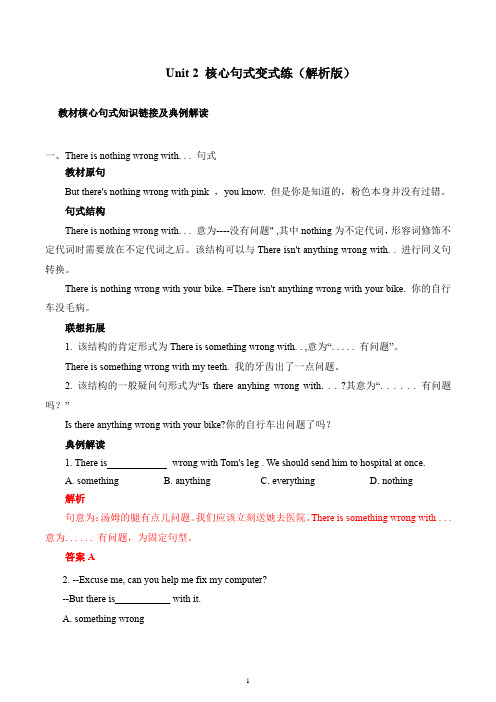
Unit 2 核心句式变式练(解析版)教材核心句式知识链接及典例解读一、There is nothing wrong with. . . 句式教材原句But there's nothing wrong with pink ,you know. 但是你是知道的,粉色本身并没有过错。
句式结构There is nothing wrong with. . . 意为----没有问题" ,其中nothing为不定代词,形容词修饰不定代词时需要放在不定代词之后。
该结构可以与There isn't anything wrong with. . 进行同义句转换。
There is nothing wrong with your bike. =There isn't anything wrong with your bike. 你的自行车没毛病。
联想拓展1. 该结构的肯定形式为There is something wrong with. . ,意为“. . . . . 有问题”。
There is something wrong with my teeth. 我的牙齿出了一点问题。
2. 该结构的一般疑问句形式为“Is there anyhing wrong with. . . ?其意为“. . . . . . 有问题吗?”Is there anything wrong with your bike?你的自行车出问题了吗?典例解读1. There is wrong with Tom's leg . We should send him to hospital at once.A. somethingB. anythingC. everythingD. nothing解析句意为:汤姆的腿有点儿问题。
我们应该立刻送她去医院。
There is something wrong with . . . 意为. . . . . . 有问题,为固定句型。
形容词和名词的用法
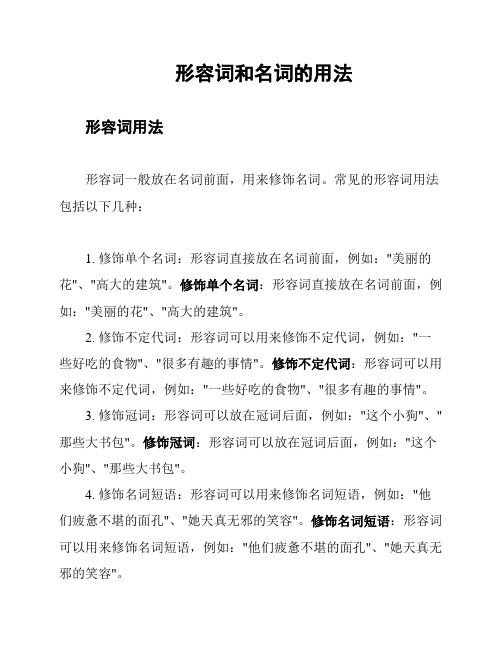
形容词和名词的用法形容词用法形容词一般放在名词前面,用来修饰名词。
常见的形容词用法包括以下几种:1. 修饰单个名词:形容词直接放在名词前面,例如:"美丽的花"、"高大的建筑"。
修饰单个名词:形容词直接放在名词前面,例如:"美丽的花"、"高大的建筑"。
2. 修饰不定代词:形容词可以用来修饰不定代词,例如:"一些好吃的食物"、"很多有趣的事情"。
修饰不定代词:形容词可以用来修饰不定代词,例如:"一些好吃的食物"、"很多有趣的事情"。
3. 修饰冠词:形容词可以放在冠词后面,例如:"这个小狗"、"那些大书包"。
修饰冠词:形容词可以放在冠词后面,例如:"这个小狗"、"那些大书包"。
4. 修饰名词短语:形容词可以用来修饰名词短语,例如:"他们疲惫不堪的面孔"、"她天真无邪的笑容"。
修饰名词短语:形容词可以用来修饰名词短语,例如:"他们疲惫不堪的面孔"、"她天真无邪的笑容"。
名词用法名词主要用于指称人、事物、地方或概念,并且在句子中担任主语、宾语、表语或定语等角色。
常见的名词用法包括以下几种:1. 作为主语:名词可以作为句子的主语,例如:"猫是宠物动物"、"成功需要努力"。
作为主语:名词可以作为句子的主语,例如:"猫是宠物动物"、"成功需要努力"。
2. 作为宾语:名词可以作为句子的宾语,例如:"我喜欢音乐"、"她研究了很多知识"。
作为宾语:名词可以作为句子的宾语,例如:"我喜欢音乐"、"她学习了很多知识"。
形容词作后置定语的规律
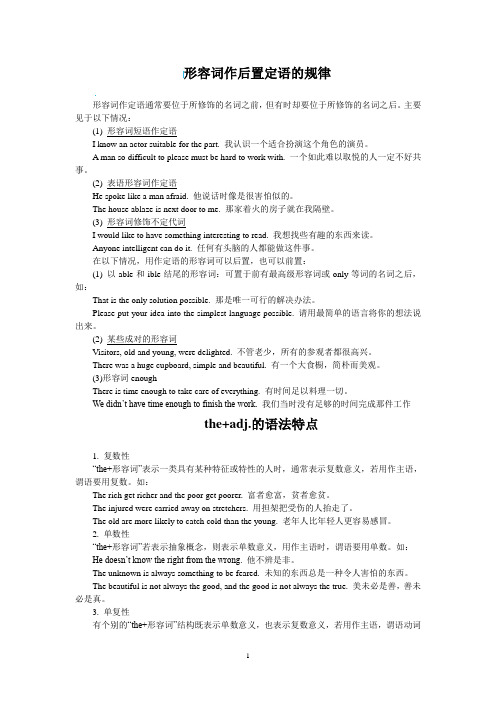
形容词作后置定语的规律形容词作定语通常要位于所修饰的名词之前,但有时却要位于所修饰的名词之后。
主要见于以下情况:(1) 形容词短语作定语I know an actor suitable for the part. 我认识一个适合扮演这个角色的演员。
A man so difficult to please must be hard to work with. 一个如此难以取悦的人一定不好共事。
(2) 表语形容词作定语He spoke like a man afraid. 他说话时像是很害怕似的。
The house ablaze is next door to me. 那家着火的房子就在我隔壁。
(3) 形容词修饰不定代词I would like to have something interesting to read. 我想找些有趣的东西来读。
Anyone intelligent can do it. 任何有头脑的人都能做这件事。
在以下情况,用作定语的形容词可以后置,也可以前置:(1) 以-able和-ible结尾的形容词:可置于前有最高级形容词或only等词的名词之后,如:That is the only solution possible. 那是唯一可行的解决办法。
Please put your idea into the simplest language possible. 请用最简单的语言将你的想法说出来。
(2) 某些成对的形容词Visitors, old and young, were delighted. 不管老少,所有的参观者都很高兴。
There was a huge cupboard, simple and beautiful. 有一个大食橱,简朴而美观。
(3)形容词enoughThere is time enough to take care of everything. 有时间足以料理一切。
形容词-副词的用法

形容词 副词的用法形容词: 一、形容词在句子中的作用及位置: 1. 作定语。
a. 形容词作定语时一般放在它所修饰的词的前面;I have a good book. He is a strange man. b. 形容词修饰不定代词(由 some, any, every, no+ thing, one, body 构成)时 要放在不定代词之后; He has something important to tell you. There is nothing interesting in the book. ) c. enough 修饰名词时可放在名词之前或之后; 修饰形容词、副词和动词 时一定要放在这些词之后. They have enough money to buy the car. They have money enough to buy the car. The hole is large enough. d. else 只作后置定语,修饰疑问代词 what, who, whom, whose 和不定代词 something, anything, nothing, somebody, anybody nobody 等;( else 作副词 时, 修饰疑问副词 when, where 等放在其后) What else can you do Is there anyone else e. 形容词短语作定语时必须放在它所修饰的词的后面。
All countries, big and small, should be equal. 任何国家,无论大小,一律平 等. f. 表示计量(长、宽、高、深)及年龄的形容词,应放在相应的名词之 后。
< 2. 作表语。
在系动词和半系动词 feel(感到),look(看起来),sound(听起来), smell(闻起来),taste(尝起来),become(变成)get(变成),turn (变成),fall(变成), seem(似乎,好象)后,用形容词作表语。
形容词作后置定语的几种常见情况
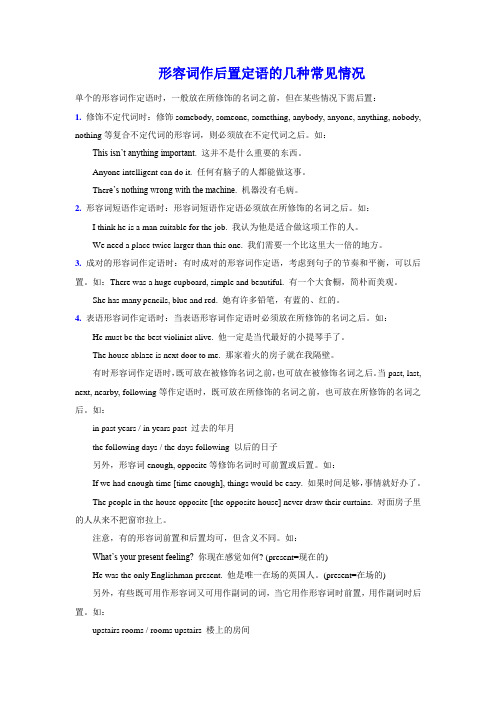
形容词作后置定语的几种常见情况单个的形容词作定语时,一般放在所修饰的名词之前,但在某些情况下需后置:1. 修饰不定代词时:修饰somebody, someone, something, anybody, anyone, anything, nobody, nothing等复合不定代词的形容词,则必须放在不定代词之后。
如:This isn’t anything important. 这并不是什么重要的东西。
Anyone intelligent can do it. 任何有脑子的人都能做这事。
Ther e’s nothing wrong with the machine. 机器没有毛病。
2. 形容词短语作定语时:形容词短语作定语必须放在所修饰的名词之后。
如:I think he is a man suitable for the job. 我认为他是适合做这项工作的人。
We need a place twice larger than this one. 我们需要一个比这里大一倍的地方。
3. 成对的形容词作定语时:有时成对的形容词作定语,考虑到句子的节奏和平衡,可以后置。
如:There was a huge cupboard, simple and beautiful. 有一个大食橱,简朴而美观。
She has many pencils, blue and red. 她有许多铅笔,有蓝的、红的。
4. 表语形容词作定语时:当表语形容词作定语时必须放在所修饰的名词之后。
如:He must be the best violinist alive. 他一定是当代最好的小提琴手了。
The house ablaze is next door to me. 那家着火的房子就在我隔壁。
有时形容词作定语时,既可放在被修饰名词之前,也可放在被修饰名词之后。
当past, last, next, nearby, following等作定语时,既可放在所修饰的名词之前,也可放在所修饰的名词之后。
定语修饰不定代词放在后面的例子

定语修饰不定代词放在后面的例子不定代词做定语都要后置。
形容词作定语修饰不定代词something,anything,nothing等时,必须放在不定代词之后。
例如:
Let's give her something different to eat,then.那我们就给她一些别的东西吃吧。
I have something important to tell you.我有一些重要的事情要告诉你。
Can you see anything unusual in the picture?你能在这幅画中看出不寻常的东西吗?
Nothing difficult!没有什么难的!
不定代词后定语从句:
1、先行词为
all,much,everything,nothing,something,anything,nothing,等不定代词时;
2、先行词被only,any,few,little,no,all,just,very,right 等修饰时。
3、当先行词是最高级或被形容词最高级修饰时。
4、当先行词是序数词或被序数词修饰时。
5、当先行词是数词时。
6、当先行词既指人又指物时。
7、如有两个定语从句,其中一个关系代词已用which,另一个关系代词则宜用that。
8、主句是There be结构,修饰其主语的定语从句宜用that作关系代词。
9、被修饰成分为表语,或者关系代词本身是定语从句的表语时,该关系代词宜用that。
10、先行词为what,关系代词用that。
11、有时为了避免重复而使用that引导定语从句。
形容词修饰不定代词的用法
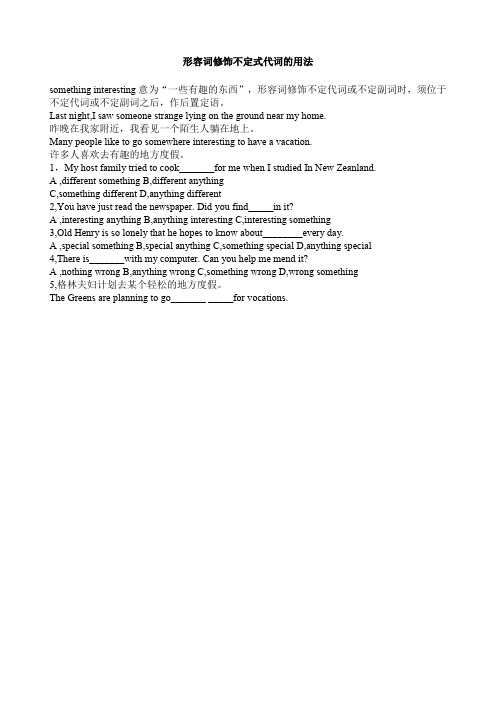
形容词修饰不定式代词的用法something interesting意为“一些有趣的东西”,形容词修饰不定代词或不定副词时,须位于不定代词或不定副词之后,作后置定语。
Last night,I saw someone strange lying on the ground near my home.昨晚在我家附近,我看见一个陌生人躺在地上。
Many people like to go somewhere interesting to have a vacation.许多人喜欢去有趣的地方度假。
1,My host family tried to cook_______for me when I studied In New Zeanland.A ,different something B,different anythingC,something different D,anything different2,You have just read the newspaper. Did you find_____in it?A ,interesting anything B,anything interesting C,interesting something3,Old Henry is so lonely that he hopes to know about________every day.A ,special something B,special anything C,something special D,anything special4,There is_______with my computer. Can you help me mend it?A ,nothing wrong B,anything wrong C,something wrong D,wrong something5,格林夫妇计划去某个轻松的地方度假。
adj和adv的用法

adj和adv的用法在英语中,形容词(adj)和副词(adv)都是描述词类,它们都有着非常重要的作用。
形容词用于描述或限定名词,而副词则用于描述或限定形容词、动词、或其他副词。
下面我们将分步骤来介绍这两种词类的用法。
一、形容词的基本用法1. 形容词用于限定或描述名词或代词,它通常位于名词或代词前面。
例如:a beautiful flower(一朵美丽的花),a tall man (一个高个子的男人)。
2. 形容词可以用来修饰不定代词,例如:something interesting(有趣的事情),anything good(好的东西),someone special(特别的人)。
3. 形容词可以用于比较级和最高级,例如:bigger(更大的),biggest(最大的)。
4. 形容词也可以作为表语,例如:The cake is delicious(这个蛋糕很好吃),She is pretty(她很漂亮)。
二、副词的基本用法1. 副词用于修饰动词、词组、形容词或其他副词,并通常位于它所修饰的词的后面。
例如:She speaks English fluently(她说英语很流利)。
2. 副词可以被用来表示时间、地点、频率、方式等等。
例如:He runs fast(他跑得很快)。
3. 副词可以用于比较级和最高级,例如:faster(更快的),fastest(最快的)。
4. 副词可以作为句子的修饰语。
例如:Unfortunately, I missed the train(不幸的是,我错过了火车)。
总之,形容词和副词都是非常重要的英语语法要素。
我们要学会正确使用它们,让我们的英语表达更加准确、地道。
形容词短语作后置定语的六种情况

形容词短语作后置定语的六种情况篇一:《形容词短语作后置定语的六种情况,我来告诉你!》嗨,小伙伴们!今天我想跟你们聊聊一个超有趣的语法知识——形容词短语作后置定语的六种情况。
你们可别一听语法就觉得头疼哦,其实这里面可藏着好多好玩的秘密呢。
第一种情况呀,就是当形容词短语修饰不定代词的时候。
比如说“something interesting”,这里的“interesting”就是形容词,它和“something”一起用的时候,就只能放在后面。
你想啊,如果说成“interesting something”,是不是感觉特别别扭,就像把衣服穿反了一样。
我记得有一次,我跟同桌小明聊天,他写作文的时候就写了“new anything”,我就赶紧告诉他,“哎呀,小明,你这样写不对呢,不定代词后面如果跟着形容词,得把形容词放后面,是‘anything new’才对呀。
”小明当时就恍然大悟,还笑着说自己差点就闹了个大笑话。
第二种情况是和表示数量的词搭配的时候。
就像“a box full of toys”,“full of toys”这个形容词短语就是在修饰“box”,表示这个盒子的状态是装满玩具的。
这就好比一个装满糖果的罐子,你不能把这个形容糖果多的短语拆开放到别的地方去,就得老老实实地放在罐子后面,就像“a jar full of candies”。
我在家里看到妈妈整理东西的时候,有个盒子里面装着好多漂亮的珠子,我就跟妈妈说:“妈妈,你看这是个box full of beads。
”妈妈还夸我会用英语描述东西了呢。
再来说说第三种情况吧。
当形容词短语表示的是一种暂时的特征或者状态的时候,它往往也是后置定语。
比如说“the man asleep in the chair”,“asleep in the chair”就是在描述这个男人当时的状态,他正在椅子上睡着呢。
这就像我们班有个同学叫小红,有一次上自习课的时候,她趴在桌子上睡着了,我们就可以说“the girl asleep on the desk”。
不定代词的用法
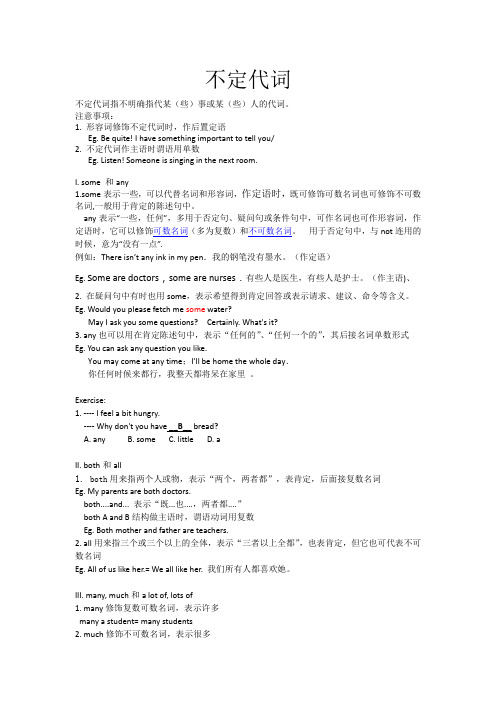
不定代词不定代词指不明确指代某(些)事或某(些)人的代词。
注意事项:1. 形容词修饰不定代词时,作后置定语Eg. Be quite! I have something important to tell you/2. 不定代词作主语时谓语用单数Eg. Listen! Someone is singing in the next room.I. some 和any1.some表示一些,可以代替名词和形容词,作定语时,既可修饰可数名词也可修饰不可数名词,一般用于肯定的陈述句中。
any表示“一些,任何”,多用于否定句、疑问句或条件句中,可作名词也可作形容词,作定语时,它可以修饰可数名词(多为复数)和不可数名词。
用于否定句中,与not连用的时候,意为“没有一点”.例如:T here isn’t any ink in my pen.我的钢笔没有墨水。
(作定语)Eg. Some are doctors,some are nurses.有些人是医生,有些人是护士。
(作主语)、2. 在疑问句中有时也用some,表示希望得到肯定回答或表示请求、建议、命令等含义。
Eg. Would you please fetch me some water?May I ask you some questions? Certainly. What's it?3. any也可以用在肯定陈述句中,表示“任何的”、“任何一个的”,其后接名词单数形式Eg. You can ask any question you like.You may come at any time;I’ll be home the whole day.你任何时候来都行,我整天都将呆在家里。
Exercise:1. ---- I feel a bit hungry.---- Why don't you have __B__ bread?A. anyB. someC. littleD. aII. both和all1. both用来指两个人或物,表示“两个,两者都”,表肯定,后面接复数名词Eg. My parents are both doctors.both....and... 表示“既...也....,两者都....”both A and B结构做主语时,谓语动词用复数Eg. Both mother and father are teachers.2. all用来指三个或三个以上的全体,表示“三者以上全都”,也表肯定,但它也可代表不可数名词Eg. All of us like her.= We all like her. 我们所有人都喜欢她。
形容词用法

形容词修饰不定代词 (something,anything,nothing)时, 通常后置, 形成:不定代词+形容词的结构。
(用在系动词和be动词的后面)
The trees turn We are
green in spring.
alone on the island.
sound
am / is / are
The old are well looked after. 老人们受到很好的照顾。
2. 形容词 与合成形容词。
1.She is an eight
– year – old girl.
= She is eitht years
old.
2. They have built a one-hundred-metre-
8. He is ___ enough to carry the heavy box . A A. strong B. stronger C. much stronger D. the strongest A 9. Beijing, the capital of China, is one of ——
far 远的
old 老的
farther 较远的 further 进一步的 older 更老的 elder 年长的
farthest 更远的 furthest 最深远的 oldest 最老的 eldest 最年长的
elder和 eldest主要用于家庭成员之间的长幼次序。 elder sister 姐姐 older 和oldest则用于表示年龄的大 小
4.多个形容词修饰一个名词时, 形容词的顺序。
大小,形状,颜色,材料
It’s a small
square _______ paper box. red
形容词修饰不定代词
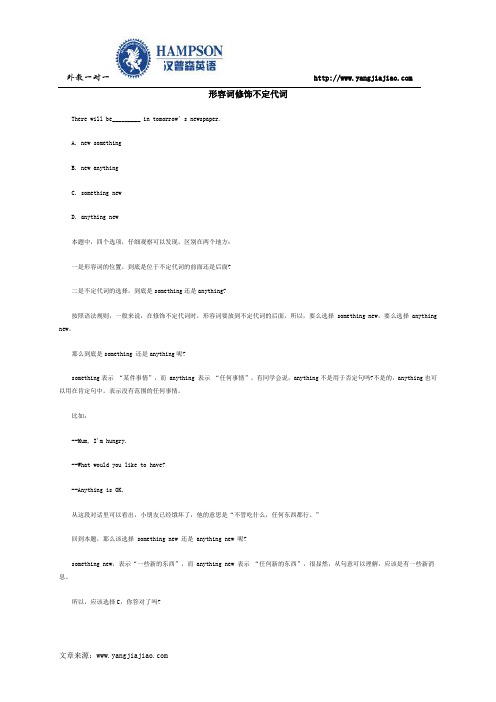
外教一对一
形容词修饰不定代词
There will be_________ in tomorrow’s newspaper.
A. new something
B. new anything
C. something new
D. anything new
本题中,四个选项,仔细观察可以发现,区别在两个地方:
一是形容词的位置,到底是位于不定代词的前面还是后面?
二是不定代词的选择,到底是something还是anything?
按照语法规则,一般来说,在修饰不定代词时,形容词要放到不定代词的后面,所以,要么选择 something new,要么选择 anything new。
那么到底是something 还是anything呢?
something表示“某件事情”,而 anything 表示“任何事情”,有同学会说,anything不是用于否定句吗?不是的,anything也可以用在肯定句中。
表示没有范围的任何事情。
比如:
--Mum, I'm hungry.
--What would you like to have?
--Anything is OK.
从这段对话里可以看出,小朋友已经饿坏了,他的意思是“不管吃什么,任何东西都行。
”
回到本题,那么该选择 something new 还是 anything new 呢?
something new,表示“一些新的东西”,而 anything new 表示“任何新的东西”,很显然,从句意可以理解,应该是有一些新消息。
所以,应该选择C,你答对了吗?
文章来源:。
英语中形容词作后置定语的十种情况
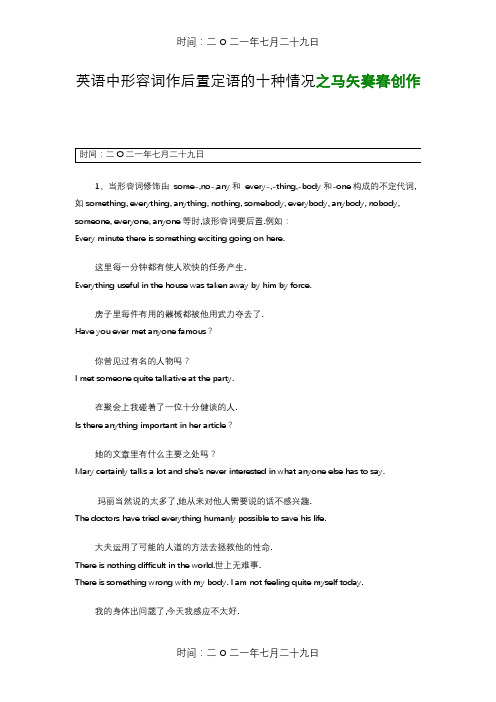
英语中形容词作后置定语的十种情况之马矢奏春创作1、当形容词修饰由some-,no-,any和every-,-thing,-body和-one构成的不定代词,如something, everything, anything, nothing, somebody, everybody, anybody, nobody, someone, everyone, anyone等时,该形容词要后置.例如:Every minute there is something exciting going on here.这里每一分钟都有使人欢快的任务产生.Everything useful in the house was taken away by him by force.房子里每件有用的器械都被他用武力夺去了.Have you ever met anyone famous?你曾见过有名的人物吗?I met someone quite talkative at the party.在聚会上我碰着了一位十分健谈的人.Is there anything important in her article?她的文章里有什么主要之处吗?Mary certainly talks a lot and she's never interested in what anyone else has to say.玛丽当然说的太多了,她从来对他人需要说的话不感兴趣.The doctors have tried everything humanly possible to save his life.大夫运用了可能的人道的方法去拯救他的性命.There is nothing difficult in the world.世上无难事.There is something wrong with my body. I am not feeling quite myself today.我的身体出问题了,今天我感应不太好.2、形容词性短语作定语时要后置,这时该短语相当于一个定语从句.例如:The basket full of fruits belongs to the beautiful girl.装满生果的这个篮子是属于这个漂亮女孩的.There was nothing big enough to weigh the elephant.没有任何称足够大,可以称这头大象.Those brave enough to take the course will certainly learn a lot of useful skills.那些选修这门课的大胆的人当然会学到许多有用的技能.3、当某些以-ble或-ible结尾的形容词具有动词色彩,并暗示主动意义时,应置于被修饰的词的后面,并且这些形容词大都和形容词最初级或all,only,every等词连用:His is the earliest edition obtainable.他那本是现在能找到的最早的版本.He is the only person reliable.他是独一靠得住的人.I have tried all means imaginable.我已测验测验了一切可想象的方法.Every message transmissible was sent out by them.每一条可广播的消息都被他们发了出去.4、由and, or等连接的两个或几个形容词作定语时常后置,从而进一步说明被修饰词的性质或特点,并起强调传染感动.例如:I like reading story-books both interesting and instructive.我爱好读那些既有味又有教诲意义的故事书.People in the village, young and old, went to see the film yesterday evening.这个村子里的人,老的、少的,昨天晚上都去看了这场片子.Power stations, large and small, have been set up all over the country.大大小小的发电站已经在全国各地建立起来.-What a nice fire you have in your fiWordStr!--你的火炉里的火多旺呀!-During the winter I like my house warm and comfortable. --在冬天我爱好我的家温暖而舒适.There are many people in the house,young and old.这座房子里有许多人,年轻的和年迈的.A scientist is a good observer,accurate,patient and objective and applies persistent and logical thought to the observations he makes.一个科学家就是一个好的不雅察者,准确、耐心和客不雅,同时对他不雅察到的材料(事实)做不竭的逻辑思虑.We should be prepared to deal with the subversion and sabotage by all ourenemies,domestic and foreign.我们必须准备对于国表里一切敌人的颠覆和破坏.5、在比较机关的句型中,修饰名词的比较机关须后置,以说明大小、若干、新旧、高矮等方面比较的情况.例如:They produced gases almost as harmful as the gases from the factories.他们排出的废气几乎和工厂排出的废气一样有害.The Smiths need a garage twice larger than this one.史密斯家需要一个比这个大一倍的车库.6、"基数词+名词(时间、度量)+形容词"构成的数量机关常放在名词之后作后置定语,以说明所修饰名词的年事、长度、深度、高度等情况.例如:He found a good place in the rocks, more than twelve feet high with a narrow entrance.他在岩石中找到一个好地方,十二英尺多高,还有一个狭窄的进口.Yesterday, a Mr. Brown, 28 years old, came to visit you.昨天,一位28岁的自称叫布朗师长教师的人来访问过你.There was an ancient tree 30 metres high.那是一棵三高的古树.They have a child three years old.他们有一个三岁的孩子.The soldiers crossed a river 4 miles wide.士兵们渡过了一条四英里宽的河.There is a leaning tower about 180 feet high. 有一个180英尺高的斜塔.7、else, left, present(出席的、在场的)等形容词作定语修饰名词时常后置,以说明名词的状态、特点等情况.例如:All the people present spoke at the meeting.所有出席的人都在会议上讲了话.I have little money left in my pocket, so I could buy nothing.我兜里没剩下几个钱了,所以我什么也不克不及买了.Anything else can I do for you, Madame?夫人,我还能为您做点此外什么吗?8、形容词连同其后面的介词短语或不定式短语一路修饰名词的时刻,该形容词及其之后的部分一并后置,作后置定语.例如:This is an article worthy of careful study.这是一篇很值得研究的文章.They are good students always ready to help others.他们是随时乐于帮忙他人的好学生.The train bound for Los Angeles has just left the station.开往洛杉矶的火车刚才驶出车站.They need more materials relevant to the present question.他们需要更多的和今朝问题有关的材料.This is a question easily accessible to beginners.这是一个易于为初学者理解的问题.People aware of their own shortcomings are wise.知道本身缺点的人是明智的.9、某些以a-开首的形容词,经常运用来作定语、表语,在作定语时要后置.这类形容词主要有asleep(睡着的),afraid(害怕的),alive(活着的),afloat(漂着的),afire(烧着的),awake, aged,ablaze(着火的)等.例如:He was the only person alive at that moment.他是那时惟一活着的人.I was only a boy aged ten at that time.当时,我才是一个十岁的孩子.There was a child asleep in the bed.一个孩子睡在床上.On their way home,they saw a house afire.在回家的路上,他们看到一座失落火的房子.We saw many things afloat.我们看见许多漂着的器械.10、当形容词前有so,more,most等词修饰时,形容词应后置.例如:I have never seen a calm so deep.我从来没见过此沉着的局面.He could not have chosen a time more favorable.他选择的机遇再好不过了.That's one of the things most precious.这是最名贵的器械之一.。
形容词修饰不定代词 八上unit1
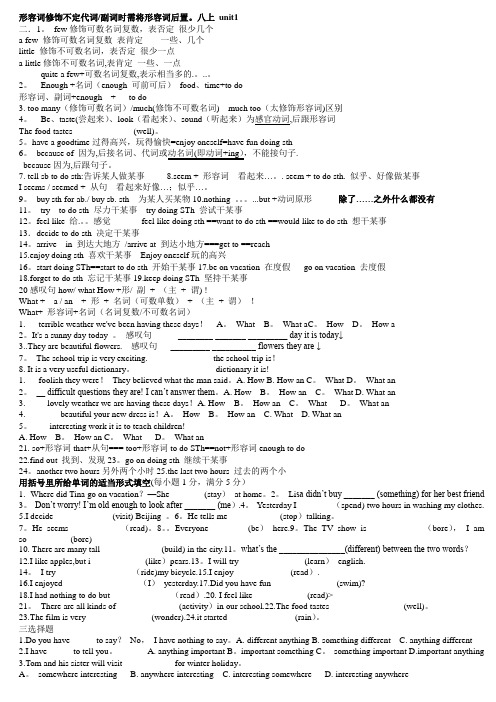
形容词修饰不定代词/副词时需将形容词后置。
八上unit1二.1。
few修饰可数名词复数,表否定很少几个a few 修饰可数名词复数表肯定一些、几个little 修饰不可数名词,表否定很少一点a little修饰不可数名词,表肯定一些、一点quite a few+可数名词复数,表示相当多的.。
..。
2。
Enough +名词(enough 可前可后)food、time+to do形容词、副词+enough + to do3. too many(修饰可数名词)/much(修饰不可数名词) much too(太修饰形容词)区别4。
Be、taste(尝起来)、look(看起来)、sound(听起来)为感官动词,后跟形容词The food tastes______________(well)。
5。
have a goodtime过得高兴,玩得愉快=enjoy oneself=have fun doing sth6。
because of 因为,后接名词、代词或动名词(即动词+ing),不能接句子.because因为,后跟句子。
7. tell sb to do sth:告诉某人做某事8.seem + 形容词看起来…。
. seem + to do sth. 似乎、好像做某事I seems / seemed + 从句看起来好像…;似乎…。
9。
buy sth for ab./ buy sb. sth 为某人买某物10.nothing 。
...but +动词原形除了……之外什么都没有11。
try to do sth 尽力干某事try doing STh 尝试干某事12。
feel like 给.。
感觉feel like doing sth ==want to do sth ==would like to do sth 想干某事13.decide to do sth 决定干某事14。
arrive in 到达大地方/arrive at 到达小地方===get to ==reach15.enjoy doing sth 喜欢干某事Enjoy oneself玩的高兴16。
- 1、下载文档前请自行甄别文档内容的完整性,平台不提供额外的编辑、内容补充、找答案等附加服务。
- 2、"仅部分预览"的文档,不可在线预览部分如存在完整性等问题,可反馈申请退款(可完整预览的文档不适用该条件!)。
- 3、如文档侵犯您的权益,请联系客服反馈,我们会尽快为您处理(人工客服工作时间:9:00-18:30)。
外教一对一
形容词修饰不定代词
There will be_________ in tomorrow’s newspaper.
A. new something
B. new anything
C. something new
D. anything new
本题中,四个选项,仔细观察可以发现,区别在两个地方:
一是形容词的位置,到底是位于不定代词的前面还是后面?
二是不定代词的选择,到底是something还是anything?
按照语法规则,一般来说,在修饰不定代词时,形容词要放到不定代词的后面,所以,要么选择 something new,要么选择 anything new。
那么到底是something 还是anything呢?
something表示“某件事情”,而 anything 表示“任何事情”,有同学会说,anything不是用于否定句吗?不是的,anything也可以用在肯定句中。
表示没有范围的任何事情。
比如:
--Mum, I'm hungry.
--What would you like to have?
--Anything is OK.
从这段对话里可以看出,小朋友已经饿坏了,他的意思是“不管吃什么,任何东西都行。
”
回到本题,那么该选择 something new 还是 anything new 呢?
something new,表示“一些新的东西”,而 anything new 表示“任何新的东西”,很显然,从句意可以理解,应该是有一些新消息。
所以,应该选择C,你答对了吗?
文章来源:。
